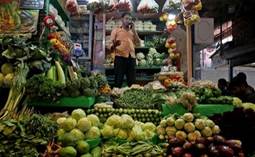
Disclaimer: Copyright infringement of intended.
Context
- India's retail inflation inched up to 7% in August from 6.71% in July mainly due to higher food prices, government data showed.
Retail inflation
- Retail inflation tracked by the Consumer Price Index (CPI) measures the changes in prices from a retail buyer's perspective.
- Wholesale inflation on the other hand is tracked by the Wholesale Price Index (WPI), measures inflation at the level of producers.
Recent Findings
- The consumer price index-based inflation is above the Reserve Bank's comfort level of 6% for the eighth month in a row. According to the data, inflation in food basket was 7.62% in August, up from 6.69% in July and 3.11% in August 2021. The rate of price rise was in excess of 10 per cent in case of vegetables, spices, footwear, and 'fuel and light' on annual basis. However, there was contraction in inflation in egg and almost flat in protein rich 'meat and fish' during the month.
- India's industrial production rose 2.4% in July. The IIP had grown 11.5% in July 2021.
- As per the Index of Industrial Production (IIP) data released by the National Statistical Office (NSO), the manufacturing sector's output grew 3.2% in July 2022.
- The mining output contracted 3.3% while power generation increased 2.3% during the same period.
- In April 2020, industrial production had contracted 57.3% due to a decline in economic activities in the wake of the lockdown imposed to curb the spread of coronavirus infections.
- Food inflation, which accounts for nearly half the CPI basket, soared as prices of essential crops like wheat, rice and pulses were driven higher by a record heatwave, squeezing household budgets. While high inflation is a global phenomenon, it is felt acutely in a country like India where millions live in abject poverty.
- The power sector showed a growth of 2.3% as against 11.1% a year ago. The mining sector witnessed a contraction of 3.3% in July 2022 whereas there was a growth of 19.5% in the year-ago period.
- During April-July this year, IIP rose 10% as against 33.9% growth in the same period a year ago.
- Capital goods output, which is a barometer of investments, rose 5.8% in July 2022 as against 30.3% growth in the year-ago month.
- The consumer durables segment grew 2.4% compared to 19.4% growth a year ago.
- The primary goods segment, which accounts for nearly 34% of the index, expanded 2.5% in July compared to 12.4% growth in the year-ago period.
Concerns and Implications
- Inflation pace is high and alarming emphasizing the fact that the high inflation has spread across most categories.
- This reflects build-up of price pressures in the economy due to persistent commodity price increases and amplified supply bottlenecks.
- India’s high import dependency for edible oils, fertilizers and crude oil, which are at all-time high prices globally, makes the outlook quite uncertain for inflation to dissipate soon.
- If retail inflation doesn’t significantly cool off from these levels, the central bank could opt to raise interest rates.

Consumer Price Index (CPI)
- Consumer Price Index (CPI) measures the inflation at retail level.
- Consumer Price Index (CPI) is a measure of change in retail prices of goods and services consumed by people in a given area with reference to a base year. CPI is calculated for a fixed list of items including food, housing, apparel, transportation, electronics, medical care, education, etc. The price data is collected periodically, and thus, the CPI is used to calculate the inflation levels in an economy.
The main uses of CPI are the following:
- It is widely considered as a barometer of inflation
- Tool for monitoring price stability
- The Reserve Bank of India is now using CPI(Combined) as the as the benchmark for its monetary policy tools like Repo Rate, Reverse Repo Rate.
- According to the Agreement on Monetary Policy Framework signed between the Government and the RBI in 2015 the sole objective of the RBI is price stability and the Consumer Price Index (Combined) is measured as the target inflation.
Consumer Price Index compiled for four groups of consumers in India:
- CPI for Industrial workers CPI(IW)
- Consumer Price Index for Urban Non-Manual Employees (UNME)
- CPI for Agricultural Labourers CPI(AL)
- CPI for Rural Labourers CPI(RL)
- While the Ministry of Statistics and Program Implementation collects CPI (UNME) data and compiles it, the remaining three are collected by the Labour Bureau in the Ministry of Labour.
Inflation Targets
- Targeted consumer price index (CPI) inflation rate is= 4%
- Upper tolerance limit of inflation is= Target inflation rate + 2% = (4% + 2%) =6%
- Lower tolerance limit of inflation is= Target inflation rate – 2% = (4% – 2%) =2%
- Targeted consumer price index (CPI) inflation rate period from = April 1, 2021
- Targeted consumer price index (CPI) inflation rate period up to = March 31, 2026
Monetary policies can target inflation levels. A low level of inflation is considered to be healthy for the economy. If inflation is high, a contractionary policy can address this issue.
Must Read:
https://www.iasgyan.in/daily-current-affairs/inflation-29#:~:text=Retail%20inflation%20based%20on%20consumer,per%20cent%20in%20February%202022.
https://www.iasgyan.in/daily-current-affairs/monetary-policy
https://www.business-standard.com/article/economy-policy/india-s-retail-inflation-rises-to-7-in-august-122091200842_1.html#:~:text=India's%20retail%20inflation%20has%20been,6%25%20for%20eight%20consecutive%20months&text=India's%20retail%20inflation%20inched%20up,government%20data%20showed%20on%20Monday




